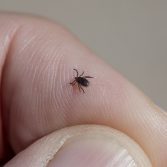A warm climate, just the right level of humidity, a green lawn or an enchanting country road: who, in such a setting, would think of ticks? Sometimes, overwhelmed by the pleasure of spending time outdoors, we don’t think about potential threats to our health and that of our pets.
So, we should ask ourselves: what do we do if we come into contact with a tick? Or, even more importantly, how can you tell if you have a tick?
Here are some elements to consider.
Ticks: learn to recognise them
Easy to say, not as easy to do: who would be able, at first glance, to recognise a tick?
Ticks are rather small parasites (i.e. millimetres or a centimetre long), with a characteristic flattened teardrop shape; usually, the male (black or very dark brown) is smaller than the female which, in addition to its size, is also recognisable by its light greyish colour. They feed on the host’s blood, whether this is an animal or humans, and their mouth is visible.
There are many species: 850 all over the world! Usually, regardless of the species, the modus operandi of ticks is always the same. They infest a mammal and remain attached for about 5 days, sucking its blood; after feeding, the tick detaches, returning to the ground for mutation at the next stage.
The duration of the life cycle varies from a few months to 3 years and the female deposits several thousand eggs on average.
But where are ticks found?
Like everyone, ticks also have ideal environments, humid and warm. You are more likely to come across the parasite in a green area, but they can also be present in the city and homes (transported unknowingly), hiding in the cracks in walls, behind skirting boards, or under carpets.
They are particularly active in summer but they are also present in spring and early autumn; they tend to be less active in the colder months of winter when they enter a state of hibernation, known as “diapause”.
How to tell if a dog or cat has a tick
Ticks, thanks to their Haller’s organ, which is a sensory instrument capable of sensing changes in temperature and carbon dioxide, find their hosts, allowing them to fall and hook onto them. Cats and dogs first and foremost. By walking along the fur of our four-legged friends, ticks identify the best area of the body to which it can silently attach itself.
They can be found anywhere, but prefer the head, the base of the ears, the lips or the sides of the eyes and tail. So pay attention to these areas of the animal’s body where they nest more; it is always good to check your pet when returning home after a walk outdoors.
It must also be said that before biting with the rostrum, the tick causes a wound (hypostome), secreting a substance which fixes the buccal system; this is why you cannot easily pull them off, the risk (as the tick is firmly in place) is of detaching the body but not the mouth, breaking them (we talk about it here: How to correctly remove a tick from your pets).
Not everyone knows, that when present and when feeding, the tick also releases some substances into the animal’s blood, with anti-inflammatory and anticoagulant effects, to lower the host’s immune defences and allow it to continue to feed undisturbed, also transmitting pathogens.
So, how do you look for ticks on cats and dogs?
By always inspecting your pet, running your fingers through its fur to find any possible rounded protuberances on the surface of the skin. But, as we said, it’s not only dogs or cats that are at risk of tick bites, humans can also be victims.
How to tell if a person has a tick and where the ticks attach themselves
Tick bites can lead to certain reactions and symptoms in humans, facilitating their recognition and discovery. These include:
- pain and swelling in the area where the tick is located;
- skin rash;
- burning and itching sensation;
- vesicles or blisters;
- headaches and nausea;
- fever and weakness.
If these symptoms are present, consult a doctor immediately.
Like with animals, ticks nestle more frequently in certain areas of the body, which correspond to the hottest/most humid areas, namely the armpits, groin and hair.
Let’s never underestimate their bite; a tick’s bite can in fact have serious consequences for our health such as Lyme disease. Do you know what that is? Find out more in our article: Ticks and Health Risks: Lyme Disease.
How to prevent tick bites
Prevention is therefore very important. You can choose to:
- use repellent sprays;
- wear light-coloured clothes, with long sleeves and long trousers;
- wear closed shoes or high boots;
- check the skin, as mentioned.
Anything else? Our ZeroBugs™ PET and ZeroBugs™ PLUS which, thanks to the diffusion of mechanical sound waves, act on the nervous system of ticks and fleas, inhibiting their movements and their biological cycle in a totally non-toxic way and without side effects. We also remind you that in August and September, we support a fundraiser for the treatment of Lyme disease: 10% of the profit from the sale of anti-tick products will be donated to Federica’s treatment, and the amount collected will then be doubled by our company.
Do you want to know more? Find out all the details here: Using ULTRASOUNDtech™ to support Federica
Sources:
